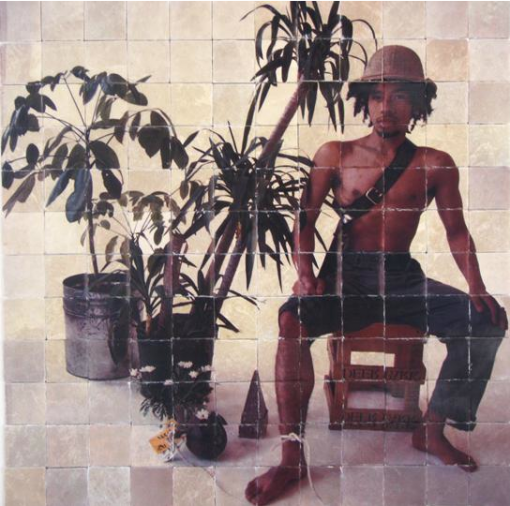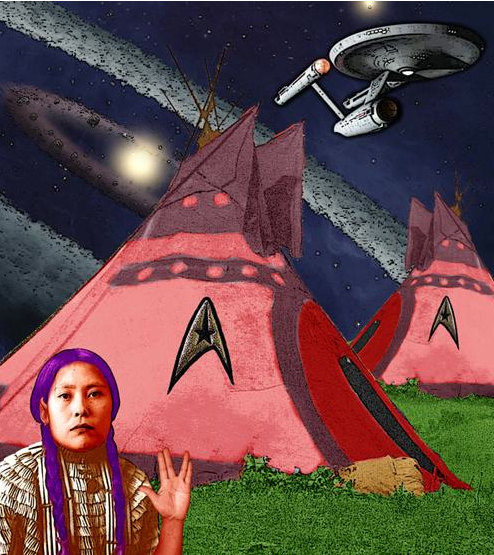Young Jean Lee, Untitled Feminist Show. Photo credit: Blaine Davis
“She mimics the speaking. That might resemble speech. (Anything at all.) Bared noise, groan, bits torn from words…From the back of her neck she releases her shoulders free. She swallows once more.”
So begins the story of the halting diseuse, or female storyteller, of Theresa Hak Kyung Cha’s genre-defying text Dictée, first published just over three decades ago in 1982. Organized in nine parts named after the Greek Muses, Dictée has been described in mythic terms – a Korean Odyssey, a rewriting of the Hesiodic Catalogue of Women, a theatrical ritual, a shamanistic exorcism. Above all, however, Cha’s work interrogates history, refracting the history of Korea in the twentieth century through the themes of exile, the displacement of colonized bodies, and the lost – and resurrected – bodies and voices of women.
Cha immigrated to the U.S. from Korea as a teenager and went on to receive her B.A. and M.F.A. at Berkeley before establishing herself as a writer, filmmaker, and performance artist in the Bay Area. Tragically, however, Cha never lived to see her large body of work achieve acclaim in both white avant-garde and Asian American circles; she was brutally murdered in New York City a week after Dictée was published. The challenging experimental nature of her work, and of Dictée in particular, meant that her legacy would remain contested for many years. How was one to interpret (if not reconcile) the relationship between the historical narratives and figures in her work and the avant-garde aesthetic of its form?
Thirty years on, however, there’s been a remarkable flourishing of this interplay among bodies, histories, and avant-garde forms in the work of Asian American theater and visual artists today, which I had the chance to catch a glimpse of in two recent shows in Chicago. In April, a friend invited me and a few other close girlfriends to go see Young Jean Lee’s touring Untitled Feminist Show at the Museum of Contemporary Art in what turned out to be an incredibly emotional experience as we huddled together in front of the stage, watching six fearless performers with female bodies – not all of whom identified as female – in the nude for the entire show, leaping, twisting, and emoting using every possible mode of expression available to them except for spoken word.
The show began with the performers, who came from the worlds of cabaret, burlesque, dance, and performance art, marching slowly down the aisles as if “gathering…for some ancient ritual” with their deep synchronized breaths magnified in surround sound. As I watched them in awe, I couldn’t help thinking of Cha’s Muses and her diseuse, shoulders squared, groaning and breathing in place of speech – that is, if they were completely naked and hilarious and awesome, growling forces of nature.
All of this could easily describe the playwright Lee herself, whose past life (English Ph.D. dropout from Berkeley) and playwriting m.o. (only tackling projects that terrify her, casting shows before writing them) have become part of her myth, as she has steadily taken over the New York avant-garde theater world with productions that can perhaps best be described as nakedly destructive, whether of Korean/Asian and African American identity politics (Songs of the Dragons Flying to Heaven, The Shipment), autobiographical sentimentality (We’re Gonna Die), or Shakespeare (Lear).
In contrast with the savagery of Lee’s previous productions, however, Untitled Feminist Show felt overwhelmingly like a celebration. In her notes for the MCA show, Lee wrote that her goal was to “make a feminist show that was fun, inspiring, and uplifting” by presenting “a world in which people with female bodies weren’t constrained into particular roles and felt free to embody whatever identities they wanted at any given moment.”
Of course, with the full spectrum of human emotion on display, there were many moments that felt abrasive, even violent: coy pink parasols turned into murder weapons; tender, erotic dances morphed into knock-down drag-out boxing matches; and in one of the most awkward and hysterical episodes, one performer slyly eyed the crowd and pointed at random gentlemen before proceeding to mime exactly what she would do with their crown jewels – namely, pleasure them, then slowly twist them into knots of agony, or worse. Strangely enough, it was during that episode that I suddenly remembered we were watching a naked female body, as if the constant nudity had lulled us into forgetting just how sexualized women’s bodies are in the “real” world.
In fact, while the show aimed to be a “utopian feminist experience,” it seemed to work most powerfully when it called attention to the fact that this isn’t the way things are; that these explosive bodies belonged to women who were circumscribed and defined by the same histories and identities as the rest of us, as we were sharply reminded when the performers reemerged at the end of the show, fully dressed in their everyday street clothes.

Albert Chong, Portrait of the Artist as a Victim of Colonial Mentality, 1979/2010 (2010). Photo via warbabylovechild.com
I must have had Dictée on the brain, because I thought of Cha’s work again a few weeks ago when I dropped by the DePaul Art Museum to see the exhibit War Baby/Love Child: Mixed Race Asian American Art, curated by DePaul and San Francisco State University professors Laura Kina and Wei Ming Dariotis. The exhibit is part of a larger project that features visual media produced by nineteen artists who hail from the rapidly expanding community of 2.6 million Americans (and counting) who identify as Asian American plus one or more ethno-racial groups. While the exhibit blurb explains that the show “examines the construction of mixed heritage Asian American identity in the United States,” this actually doesn’t do justice to its ambitious range, which not only investigates the historical origins of these identities (U.S. wars in Asia, colonialism, transnational adoption, the 1967 Supreme Court decision Loving v. Virginia outlawing laws against interracial marriage) but breaks down insidious present-day theories about “post-racialness,” while also featuring work by a younger generation of artists who seem to stay out of the conversation completely.
In an interview, Dariotis revealed that the title of the exhibit was inspired by her own experience fielding annoying questions about her background (which, incidentally, is Chinese, Greek, Swedish, English, Scottish, German, and Dutch). According to Dariotis, people would inquire whether her parents “met in the war.” “And I always ask myself, ha, I was born in 1969, we were not at war with China in 1969. Where did they get this image?” Dariotis’s story highlights persistent mainstream assumptions about mixed-race (if not mixed-ethnic) Asian Americans of a certain age as either/or – that is, either the product of military personnel and Asian women, or free-love hippies indulging in illegal interracial sex. If Young Jean Lee’s Untitled Feminist Show offers a critique of the sexualizing of women’s bodies, War Baby/Love Child draws attention to the cultural sexualization of specifically Asian (and mostly female) bodies through the bodies of their mixed-race offspring.

Debra Yepa-Pappan, Live Long and Prosper (Spock Was a Half-Breed) (2008).
Photo via warbabylovechild.com
Intriguingly, co-curator Laura Kina observed – based on interviews with the artists – that those who passed as more “white” tended to produce and/or talk about their work in terms of “universal” themes and formal aesthetics more so than those artists whose race and ethnicities were more visually ascribed on their bodies. This seemed to be confirmed by the Chinese and Black Jamaican artist Albert Chong who argued, “I don’t think you can say anything meaningful with abstraction, period. There’s no way of doing the narrative; it needs representation to communicate.” On the other end of the spectrum was the work of Laurel Nakadate (Japanese, Irish, Scottish, Welsh, Cherokee), who described her art as being “about free fall, toying with danger and desire and its relationship to failure.”
Of course, this bodily ascription/formal aesthetic binary wasn’t entirely consistent throughout: the Indian and African American artist Mequitta Ahuja’s fiery painting Dream Region (2009), an “automythography” of dreams, Indian clothing, and African American hair, was one of the most technically intricate and arresting works on display, and even works that seemed more straightforwardly representational – such as the Filipino and European American artist Jenifer Wofford’s painting MacArthur Nurses VI (2013), featuring a group of Filipino nurses marching in the same formation as General Douglas MacArthur and his troops in a famous staged photo in the Philippines in 1944 – required careful unpacking through an understanding of both ethno-cultural history and artistic representation.
All in all, I came away from War Baby/Love Child with a fresh appreciation for the infinitely possible – and infinitely complicated – relationships between aesthetics and history. Like Cha’s Dictée and Young Jean Lee’s Untitled Feminist Show, many of the art works in War Baby/Love Child channel corporeal forms to represent fraught histories (sexual, racial, colonial) and to challenge the false myth of the so-called “transcendence” of “universal” art without history or content. In doing so, these works present us with the argument that their supposedly marginal representations are in fact an important lens through which the American public needs to reexamine – and redefine – its histories, its assumptions, and its identities.
***
Young Jean Lee’s Untitled Feminist Show will be presented at the Yerba Buena Center for the Arts in San Francisco on January 30, 31, and February 1, 2014. War Baby/Love Child: Mixed Race Asian American Art is currently running at the DePaul University Art Museum in Chicago until June 30. It will reopen in Seattle at the Wing Luke Museum of the Asian Pacific American Experience on August 9, where it will run until January 19, 2014.









Comments